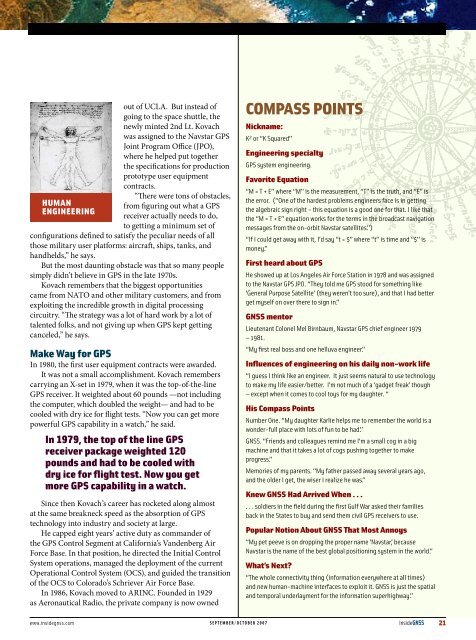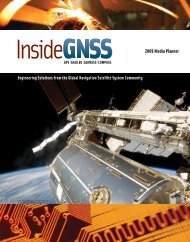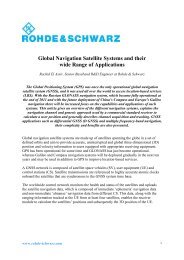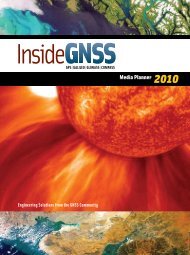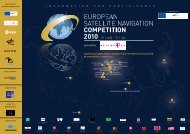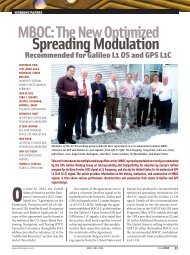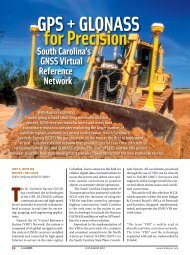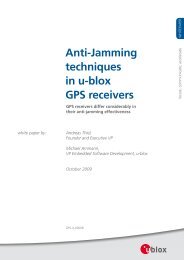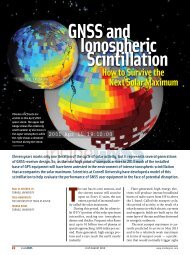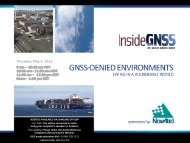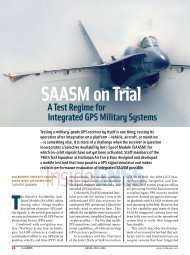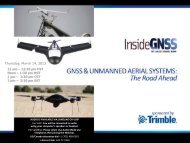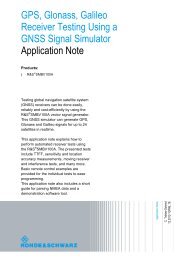Download this article (PDF) - Inside GNSS
Download this article (PDF) - Inside GNSS
Download this article (PDF) - Inside GNSS
You also want an ePaper? Increase the reach of your titles
YUMPU automatically turns print PDFs into web optimized ePapers that Google loves.
HUMAN<br />
Engineering<br />
out of UCLA. But instead of<br />
going to the space shuttle, the<br />
newly minted 2nd Lt. Kovach<br />
was assigned to the Navstar GPS<br />
Joint Program Office (JPO),<br />
where he helped put together<br />
the specifications for production<br />
prototype user equipment<br />
contracts.<br />
“There were tons of obstacles,<br />
from figuring out what a GPS<br />
receiver actually needs to do,<br />
to getting a minimum set of<br />
configurations defined to satisfy the peculiar needs of all<br />
those military user platforms: aircraft, ships, tanks, and<br />
handhelds,” he says.<br />
But the most daunting obstacle was that so many people<br />
simply didn’t believe in GPS in the late 1970s.<br />
Kovach remembers that the biggest opportunities<br />
came from NATO and other military customers, and from<br />
exploiting the incredible growth in digital processing<br />
circuitry. “The strategy was a lot of hard work by a lot of<br />
talented folks, and not giving up when GPS kept getting<br />
canceled,” he says.<br />
Make Way for GPS<br />
In 1980, the first user equipment contracts were awarded.<br />
It was not a small accomplishment. Kovach remembers<br />
carrying an X-set in 1979, when it was the top-of-the-line<br />
GPS receiver. It weighted about 60 pounds —not including<br />
the computer, which doubled the weight— and had to be<br />
cooled with dry ice for flight tests. “Now you can get more<br />
powerful GPS capability in a watch,” he said.<br />
In 1979, the top of the line GPS<br />
receiver package weighted 120<br />
pounds and had to be cooled with<br />
dry ice for flight test. Now you get<br />
more GPS capability in a watch.<br />
Since then Kovach’s career has rocketed along almost<br />
at the same breakneck speed as the absorption of GPS<br />
technology into industry and society at large.<br />
He capped eight years’ active duty as commander of<br />
the GPS Control Segment at California’s Vandenberg Air<br />
Force Base. In that position, he directed the Initial Control<br />
System operations, managed the deployment of the current<br />
Operational Control System (OCS), and guided the transition<br />
of the OCS to Colorado’s Schriever Air Force Base.<br />
In 1986, Kovach moved to ARINC. Founded in 1929<br />
as Aeronautical Radio, the private company is now owned<br />
COMPASS POINTS<br />
Nickname:<br />
K 2 or “K Squared”<br />
Engineering specialty<br />
GPS system engineering.<br />
Favorite Equation<br />
“M = T + E” where “M” is the measurement, “T” is the truth, and “E” is<br />
the error. (“One of the hardest problems engineers face is in getting<br />
the algebraic sign right – <strong>this</strong> equation is a good one for that. I like that<br />
the “M = T + E” equation works for the terms in the broadcast navigation<br />
messages from the on-orbit Navstar satellites.”)<br />
“If I could get away with it, I’d say “t = $” where “t” is time and “$” is<br />
money.”<br />
First heard about GPS<br />
He showed up at Los Angeles Air Force Station in 1978 and was assigned<br />
to the Navstar GPS JPO. “They told me GPS stood for something like<br />
‘General Purpose Satellite’ (they weren’t too sure), and that I had better<br />
get myself on over there to sign in.”<br />
<strong>GNSS</strong> mentor<br />
Lieutenant Colonel Mel Birnbaum, Navstar GPS chief engineer 1979<br />
— 1981.<br />
“My first real boss and one helluva engineer.”<br />
Influences of engineering on his daily non-work life<br />
“I guess I think like an engineer. It just seems natural to use technology<br />
to make my life easier/better. I’m not much of a ‘gadget freak’ though<br />
— except when it comes to cool toys for my daughter. “<br />
His Compass Points<br />
Number One. “My daughter Karlie helps me to remember the world is a<br />
wonder-full place with lots of fun to be had.”<br />
<strong>GNSS</strong>. “Friends and colleagues remind me I’m a small cog in a big<br />
machine and that it takes a lot of cogs pushing together to make<br />
progress.”<br />
Memories of my parents. “My father passed away several years ago,<br />
and the older I get, the wiser I realize he was.”<br />
Knew <strong>GNSS</strong> Had Arrived When . . .<br />
. . . soldiers in the field during the first Gulf War asked their families<br />
back in the States to buy and send them civil GPS receivers to use.<br />
Popular Notion About <strong>GNSS</strong> That Most Annoys<br />
“My pet peeve is on dropping the proper name ‘Navstar,’ because<br />
Navstar is the name of the best global positioning system in the world.”<br />
What’s Next?<br />
“The whole connectivity thing (information everywhere at all times)<br />
and new human-machine interfaces to exploit it. <strong>GNSS</strong> is just the spatial<br />
and temporal underlayment for the information superhighway.”<br />
www.insidegnss.com september/october 2007 <strong>Inside</strong><strong>GNSS</strong> 21


